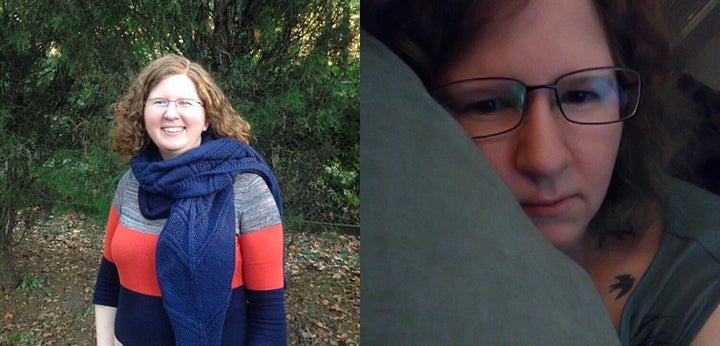
On my way to a friend’s wedding just outside New York City in 2013, I made the mistake of trying to travel by bus rather than taking a taxi from the airport. At rush hour.
As a frequent traveler, I considered myself quite adept at navigating public transportation, but I was not prepared for how inaccessible a seemingly mundane 45-minute bus ride around the city had become for me. Though I was in my mid-20s and looked reasonably healthy, my vascular system was collapsing on the inside.
It was my first solo trip after being diagnosed with postural orthostatic tachycardia syndrome (POTS), a condition in which my blood vessels don’t contract properly, allowing blood to pool in my extremities and causing severe dizziness and other symptoms.
With a nervous system that no longer regulated blood flow correctly, I experienced dizziness, pain and excruciating fatigue if I stood up for more than 10 minutes at a time. As the bus made its way around the city, I could feel my heart rate rising and my blood pressure dropping. My body was struggling to keep blood circulating to my brain, and if I didn’t sit down soon, I could collapse entirely ― potentially missing out on the wedding I’d traveled hundreds of miles to attend.
I looked around at the other passengers and thought desperately about asking for a seat. As I gripped my suitcase for dear life, I considered how the conversation might go. Would I have given up my seat to someone who looked like a young, whiny, entitled white woman? Probably not. So how would I ever convince a total stranger that I was actually disabled? And even if I could, did I really want to?
Invisible disabilities affect more than 1 in 10 Americans, but people with those conditions often choose to hide them. Among those who have difficulty walking a quarter-mile (13.4% of all U.S. adults in 2014) or climbing a flight of stairs (12.1% of adults), less than half (42.7%) use a mobility aid such as crutches or a wheelchair.
There are many reasons for this, but stigma and other social factors play a large role. Unemployment rates for disabled people are twice as high as those for the able-bodied, and marriage rates average around half those of the general population. Disabled people can also be paid less than the minimum wage with federal approval. The visibly disabled, such as wheelchair users and people with obvious physical differences, bear the brunt of this discrimination.
On the flip side, however, when people with hidden conditions use accommodations like disabled parking spaces or motorized carts, they often face harassment for not looking disabled enough. This risk increases dramatically for people with multiple marginalized identities. (I’m young, white and relatively thin, so more people seem to give me the benefit of the doubt.)
My own reasons for trying to appear able-bodied long after my diagnosis went deeper than fear of stigma, exclusion or condescension. Although I don’t remember hearing anyone actively disparage disabled people when I was growing up, I did internalize a strong drive to be “productive” and meet society’s definition of a capable, independent, responsible person.
“On days when I felt OK (although still at only about 30% of my former capacity), I would try to accomplish everything on my to-do list. I would then rest for three or four days afterward to recover.”
Self-reliance was a core part of my identity. Before I got sick, I earned a master’s degree in chemistry from the University of Oxford and moved to Germany on my own to start a Ph.D. program. It was difficult to reconcile my former jet-setting life with barely being able to make it to an out-of-state wedding on my own. I worked hard to keep up appearances so I could assure myself I was still a valuable, contributing member of society, not a “freeloader” or other pejorative often aimed at people who need extra support.
My strategy was simple: On days when I felt OK (although still at only about 30% of my former capacity), I would try to accomplish everything on my to-do list. I would then rest for three or four days afterward to recover.
I would push myself to run errands, visit with friends and go to coffee shops or events all in one day so that no one knew how debilitating my condition really was. I’d then spend the next several days in bed with brain fog, pain and fatigue so great that it was difficult to walk to the bathroom and back without hunching over and clinging to the wall for support.
My identity was split in two. I saved all my energy to fuel my public persona, leaving nothing for myself. I hoped I would one day find a magical cure that would return me to my former abilities. In the meantime, I traded days of pain and exhaustion for a few hours of looking normal. I didn’t want to admit that the pace of what I considered a “successful” life was no longer sustainable for me.
But when it became clear there would be no immediate cure (despite a chorus of online diet, nutrition and alternative treatment websites claiming otherwise), I started to focus my limited energy on creating a new life for myself. I found a house in the city with roommates, joined online writers’ groups and began dating.
I read everything I could by activists like Imani Barbarin, Julian Van Horne and Tricia Hersey (Crutches_And_Spice, TheDisabledHippie, and TheNapMinistry on Instagram, respectively), and I learned how ableism intersects with other systems of oppression and exploitation.
The roadmap they offered felt like liberation. They taught me that a person’s value isn’t dependent on how much they contribute to the economy and that we all deserve support and care just by existing. They opened my eyes to the real-world communities of mutual aid that can grow out of these beliefs.
In the beginning, it was difficult to let myself rest, even with the ultimate doctor’s note. I felt like I still had to push past my (extremely limited) capabilities. I had to practice slowing down and allowing my frailties to become visible even when I had the choice to hide them. I had to resist the urge to do things “just because I could” if they would hurt me in the long run.
I began testing different accommodations, like asking for footrests at other people’s houses to keep blood from pooling in my legs or walking with hiking sticks for support. After a major pep talk over text with a friend and the unwavering encouragement of my partner, I even wore pajamas to game night because I realized my friends would want me to spend my energy participating rather than dressing to fit in (I could do only one).
“Why should ‘capable’ look a certain way if it wasn’t healthy for me? What good is trying to be ‘normal’ if those standards aren’t accessible to everyone?”
I finally started to believe that it was more important to show up as my full self than to keep up old appearances.
Or at least I thought I did, until one day my therapist picked up on the fact that I was uncomfortable sitting on her couch. She asked if it would be better to sit on the floor, and I froze. Yes, it would be better ― with my legs no longer dangling below my heart, my body would have a much easier time getting blood where it needed to go.
I knew my therapist’s office was a place where I could be fully myself, but to sit on the floor in front of a medical professional felt incredibly daunting. Crying in front of her was one thing, but admitting that my body wasn’t fully functional? What if she didn’t think I was competent or capable anymore?
I remembered all the reading I had done. My fears were real enough, but they also reflected a lot of internalized ableism. Why should “capable” look a certain way if it wasn’t healthy for me? What good is trying to be “normal” if those standards aren’t accessible to everyone?
If I hid my body’s unique needs, I was exiling a whole portion of my existence, as well as that of people more visibly disabled than me. By trying to appear able-bodied, I was only propping up a system that makes life miserable for millions of others, including able-bodied people. A culture that celebrates “the grind” stigmatizes anyone who acknowledges their limitations and needs for rest and support.
So I did it. I grabbed a pillow and slid off the couch. Sitting on the floor, I could breathe again. I settled into my body, and as I felt the difference, I promised I would learn to honor and care for my own needs.
My old ideas of “success” and “productivity” still loom large in my mind at times, but I’ve slowly shifted my expectations for work and socializing toward gentler assessments that take my body into account. (I work for an hour and I rest in the middle when I need to. Well done!)
I’ve learned a lot about living with an invisible disability since that solo bus ride on the way to my friend’s wedding (which I did make it to in the end, thanks to eventually plenty of rest and very generous assistance from the bride and her family). I still travel, but I now walk with a cane, both for balance and to indicate that parts of my body don’t work the way they might appear to. I feel more comfortable asking for a seat if I need it or even sitting on the floor if it’s my only option, regardless of how it looks. (This is, in itself, part of my privilege: People are less likely to harass me than others, so I have the option to be more visible without serious repercussions.)
To help normalize my needs, I now share pictures of the difficult days on social media, of the pills and compression stockings and other accommodations that help me stay upright and able to access the world. I try to make sure I slow down and take breaks, even in environments where speed and efficiency are prioritized over physical needs.
I do these things to advocate for myself, both by caring for my body and by reminding myself that in a just society ― a society I believe we can build ― we will no longer need to hide what makes us human.
Do you have a personal story you’d like to see published on HuffPost? Find out what we’re looking for here and send us a pitch!
